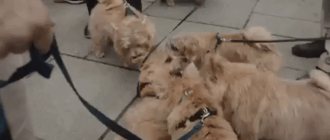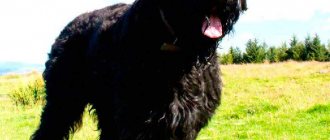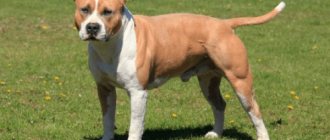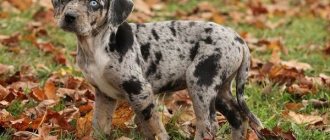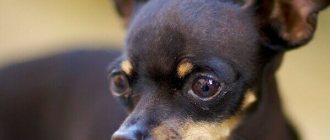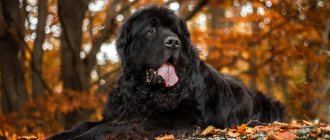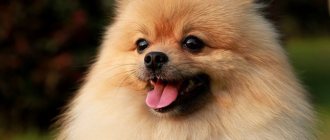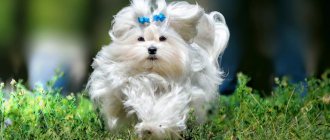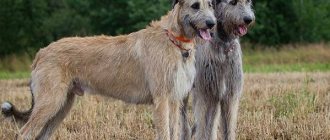Breed traits
Breed traits (on a 5-point scale)
| Kerry Blue Terrier | |||
| Activity | in the house | 4 | |
| on the street | 4 | ||
| Obedience | training | 3 | |
| strangers | 3 | ||
| Domination | in family | 2 | |
| over dogs | 3 | ||
| Defending your territory | from people | 2.5 | |
| from dogs | 4.7 | ||
| Sociability | in family | 4 | |
| with strangers | 4 | ||
| with dogs | 2 | ||
| Concentration | in family | 1.5 | |
| in front of strangers | 2 | ||
| with dogs | 4 | ||
| Aggressiveness | in family | 1 | |
| to strangers | 2 | ||
| to the dogs | 4.5 | ||
| to cats | 4 | ||
| Family behavior | calmness | 3.7 | |
| demand for affection | 4.8 | ||
| excitability | 4 | ||
| playfulness | 4 | ||
| excessive barking | 2 | ||
| behavioral breakdowns | 2 | ||
| Tolerance for children | up to 4 years | 4 | |
| over 4 years old | 4 | ||
| Institutional use | watchman | 4 | |
| bodyguard | 1.3 | ||
This breed is often compared to the following dog breeds: Miniature Schnauzer (Standard Schnauzer), Airedale Terrier, Irish Soft Coated Wheaten Terrier (Whiten Terrier), Miniature Schnauzer (Dwarf Schnauzer), Labrador Retriever.
Photos of Kerry Blue Terriers:
Vaccinations
Kerry blue terriers are first vaccinated at 8-9 weeks with a complex vaccine against:
- carnivore plague;
- hepatitis A;
- parainfluenza;
- viral enteritis.
To strengthen immunity, after 21 days the animals are revaccinated with the addition of a vaccine against leptospirosis. After the end of the teeth change (at 7 months), an anti-rabies injection is given.
The veterinarian has the right to change the vaccination schedule, guided by the condition of the pet and the epidemiological situation in a certain area.
Adult dogs are vaccinated every year, dewormed once every 3 months, and treated against fleas and ticks in the warm season. Information about vaccinations done is included in the veterinary passport.
general characteristics
Kerry Blue Terrier dogs were bred in County Kerry, Ireland. This explains the first part of the name. The word "blue" refers to the unusual bluish color of the coat. Previously, these dogs were used as shepherds, hunters, they exterminated rats, and guarded the house. Now it is the ideal companion for active owners. The breed is a symbol of Ireland, the country's national pride.
The all-purpose work these terriers did in the past has influenced their character. These are smart, independent, hardy and brave dogs. They can guard the house, exterminate rats on the property, hunt birds and small game. They are very attached to their owner and family members, treat everyone kindly, and love children. This dog can become a devoted companion.
| Options | Characteristic |
| breed name | Kerry Blue Terrier |
| a country | Ireland |
| breed group | terriers |
| life expectancy | 12-15 years |
| height | 44-49 cm |
| weight | 15-18 kg |
| aggressiveness | not aggressive towards humans |
| activity | needs high physical activity |
| intelligence | smart, quick-witted |
| care | requires special grooming, although does not shed much |
pros
Irish Blue Terriers are popular due to their good-natured, cheerful character and original appearance. This funny, playful dog is ready to accompany his owner everywhere, amusing him with his antics. Representatives of the breed are unpretentious, do not require serious care and live quietly both in a private house and in a city apartment. They have several more advantages:
- smart, quick-witted;
- cheerful, active and playful;
- loyal, sociable;
- get along well with children;
- can guard the house;
- the wool hardly sheds, does not smell, does not cause allergies;
- have good health and long life expectancy.
Minuses
This breed is not suitable for people with a soft character and inexperienced in raising terriers. If a pet is not given enough attention and education from an early age, it can grow up arrogant and uncontrollable. These dogs have several other disadvantages that can become a problem:
- prone to dominance;
- can be stubborn and headstrong;
- they love to gnaw everything, dig the ground;
- come into conflict with other dogs;
- They do not get along well with pets because they see them as prey.
Interesting videos complement the description of these dogs:
Video: Kerry Blue Terrier. Pros and cons, price, how to choose, facts, care, history
Video: Kerry Blue Terrier. Breed characteristics, care
Character
A true Kerry Blue Terrier is an aristocratic, delicate, intelligent dog with an innate sense of self-esteem, restrained in expressing feelings, neat in everyday life, incredibly hardy and persistent, has endless patience and an extraordinary mind. Kerry Blue is an incorrigible optimist, very sociable, but unobtrusive. Gets along well with children of any age, patient with the child's pranks. In any activity he is very passionate and energetic, perhaps a little less temperamental than other working terriers. A cheerful and curious Kerry does not tolerate loneliness well, he should always be in the center of events and loves attention very much.
On the one hand, Kerry is very independent, he will look into my mouth like a shepherd, waiting for orders. But on the other hand, he is very sensitive and people-oriented, trying to please the owner in everything. With his own people he is very gentle and affectionate, sincere and unforgiving. He is a devoted companion who is always and everywhere ready to accompany his loved ones.
Temperament can vary greatly depending on the breeding line. Some are calmer, others are very temperamental.
One cannot ignore the innate protective and hunting instincts. The carry will always notify you of the approach of strangers with a loud bark, and if necessary, he will come to the defense without hesitation. However, specifically instilling anger in him or engaging in ZKS means ruining the character and psyche of the dog. The modern Kerry Blue Terrier is primarily a companion, a friendly, active and confident family dog.
One of the characteristic features of terriers is aggression towards fellow tribesmen. You can teach a Kerry not to conflict, but he will never refuse to accept a fight initiated by another dog. Other difficult traits include stubbornness, desire for independence and dominance in the family. Kerry is as stubborn as a herd of sheep and is not averse to testing his owner's patience from time to time. He often achieves what he wants with the help of cunning and charisma.
History of the origin of the breed
It is unknown how long ago the breed was formed and from which ancestors it originated. The Irish consider it ancient, noting that medium-sized terriers have long been kept on the island. They helped hunt, guarded the farm, grazed livestock, and protected crops from rodents. These dogs were universal, they were kept in almost every peasant family.
Many researchers believe that the breed originated from Irish wolfhounds and black and tan English terriers. The unusual appearance and special coat structure could have been formed from crossing with wheaten terriers, Bedlingtons and even poodles. These dogs were bred in County Kerry. At the end of the 19th century, breeders noticed them and they began to be exhibited.
At the beginning of the 20th century, the breed was officially recognized and called the Kerry Blue Terrier. A standard was developed and breed clubs were created. These dogs began to spread throughout the world. They appeared in Russia in the 60s.
Interesting Facts
- Kerry Blue Terriers are a multifunctional breed. At home, they protect herds of livestock and farmers' property, and hunt a wide variety of game, including waterfowl.
- Animals with a darker coat color often win at shows. This has led to an overall darkening of the breed's color, although Kerry Blue Terriers with light blue fur are never culled.
- Another name for the breed is Irish Blue Terrier.
Expert opinion
Leonid Rodin
Experienced dog breeder
Ask a Question
The Kerry Blue Terrier can historically be called a male dog. For some reason, it was the representatives of the stronger half of humanity who appreciated this noble dog. The most famous of the blue terriers was most likely Prisoner 224, owned by Michael Collins, a statesman and fighter for Irish independence. During the revolutionary confrontation between Britain and Ireland in 1920, the parties decided to postpone the fight in order to hold a terrier exhibition. At this tournament, "Prisoner 224" won the cup, and his owner's name is still engraved on the Kennel Club's honorary award. Collins even wanted to make the Kerry Blue Terrier the official national symbol of a free Ireland, but his early death prevented this plan from coming true. Later, famous boxers fell in love with Kerry Blue Terriers. Such a dog was owned by the English heavyweight Henry Cooper, who became famous for knocking down Muhammad Ali himself. Later, the no less eminent Jack Dempsey picked up the baton of the Kerry Blue Terriers. He was so aggressive in the ring that he even became Mike Tyson's idol. World champion Gene Tunney is another owner of a blue Irish terrier. Among the fans and owners of Kerry Blue were the American singer and TV presenter Perry Como, film directors Michael Mann and Alfred Hitchcock. Unfortunately, such an eminent circle of fans could not save the breed. It is listed as endangered by international canine organizations, and registrations of new puppies have long been below 300 entries per year.
Kerry Blue Terrier standard
This is a compact, medium-sized dog with a strong, muscular build. Height at the withers is 44-49 cm, weight 15-18 kg. Males are slightly larger and heavier than females. Kerry Blue Terriers look elegant and attractive. Characteristic features of appearance are thick wavy fur of a beautiful bluish color, an elongated wide muzzle with a long beard and bangs.
Head
The head is large, proportional to the body. The muzzle is medium in size, elongated. The length of the skull from the occipital protuberance to the tip of the nose is ½ the height at the withers. The jaws are powerful, with a scissor bite, the lips and gums are black. The stop is almost invisible, the bridge of the nose is smooth, the lobe is large, black, the nostrils are wide.
The eyes are medium size, wide set. Must be dark. The look is smart, inquisitive. The ears are thin, small, triangular in shape. Placed high and close to each other. Semi-erect: form a fold in the middle, the base stands vertically, the tips hang down.
Frame
The neck is long, muscular, gracefully curved, and flows into a pronounced withers. The body is harmoniously built, square in format, sinewy. The line of the back is smooth, located horizontally, the loin is short. The chest is quite wide, the stomach is moderately tucked.
The tail is thin, not long, saber-shaped. In some countries it is still stopped. The tail is held vertically or bent into a semi-circle, but is not carried over the back.
Limbs
The limbs are smooth, long, densely covered with hair. Placed parallel, rear ones slightly set back. The shoulder blades are oblique, the elbows are pressed to the body. The hips are large, the hock joints are well defined. The paws are small with dense pads.
Coat and color
The coat is lush, soft, and of medium length. It has water-repellent properties and is silky to the touch. There is no undercoat. The top hair is slightly wavy and should not be curly. The Kerry Blue Terrier has especially long hair on the head and face: it forms bangs, a beard and mustache. There are thick feathers on the legs.
According to the standard, the color of representatives of the breed should be blue or ash-gray. The color can be any shade, lighter or darker. A small white spot on the chest, black markings on the body or darker tips of the hairs are acceptable. The peculiarity of the breed is that the bluish color is formed only after 1.5 years.
The photo will complement the description of the appearance of the representatives of the breed:
Briefly about the main thing
- The breed was developed almost two hundred years ago and was originally used as a human assistant in hunting and housekeeping.
- Kerry is a medium-sized dog, with a maximum height of only 48-49 cm in both sexes of the breed.
- The breed standard allows any shade of blue: the coat can be from dark steel to light silver.
- This is a great companion for you and your children, but only if it is the only pet in the family. Not a single representative of the breed will agree to share the owner with other animals.
- Representatives of the breed are prone to a large number of different diseases, and therefore require constant care. The ears, eyes and stomach are especially susceptible to disease.
- Feeding dogs of this species requires compliance with certain rules, violation of which leads to the development of serious diseases.
- It is better to buy a puppy from a nursery from 5,000 rubles.
Characteristics of Kerry Blue Terriers
These dogs are very sociable and need to be close to people. They become strongly attached to all family members and do not single out any one person. Children are loved, but not looked after, but perceived as companions. They play with them, are ready to obey and follow commands, but do not tolerate rudeness and ridicule. The Kerry Blue Terrier easily becomes a family favorite. He loves to play pranks, he has imagination and a sense of humor. Representatives of the breed are very jumping and capable of performing various tricks.
Among the character traits of Irish Blue Terriers, the following can be noted:
- curiosity;
- independence;
- stubbornness;
- touchiness;
- cheerfulness;
- gambling;
- sociability;
- devotion;
- emotionality.
The Kerry Blue Terrier has strong hunting instincts. Therefore, on the street he will chase cats, birds, and can exterminate rodents on the site. This dog cannot be called peace-loving - he likes to conflict with other dogs and even fight. But he treats those pets with whom he lives in the same house from an early age patiently.
Representatives of this breed also have watchdog qualities. They are wary of strangers. This is a vigilant and brave guard. Reacts quickly to a dangerous situation or aggression from strangers. And these dogs bite painfully, they have powerful jaws and a strong grip.
Education and training
Cary Blue Terriers are very smart, quick-witted, and learn quickly. But they are stubborn, do not tolerate coercion, and are easily distracted. For dog training to be effective, you need to find the right approach. Dog handlers give the following recommendations:
- training should begin as early as possible;
- classes must be regular and consistent;
- It is advisable to conduct training in the form of a game, this dog will not do anything that is not interesting to him;
- classes should be short - no more than 10 minutes;
- the dog should not be distracted by anything;
- commands must be given firmly and persistently;
- exclude physical punishment and rudeness.
Irish Blue Terriers tend to be dominant. Therefore, the puppy immediately needs to be shown who is boss in the house. It is important to immediately stop attempts to jump on a person, bite their legs and arms, or growl. The puppy is immediately taught to respond to its name, to know its place, bowl, and daily routine. The first commands are “to me”, “place”, “you can’t”, “sit”, “near”, “stand”. You cannot call a dog to punish or take it home.
Education and training
Each Kerry Blue Terrier is a bright individual, so even an experienced dog handler cannot predict how easy it will be for a particular puppy to learn. However, almost all trainers note the breed's innate stubbornness when it comes to forcing them to practice. The reason for stubbornness lies in the fact that it is difficult for a carry to concentrate on things that seem obviously boring to him. In addition, this comrade constantly switches to external stimuli, such as a scurrying mouse or a fellow tribesman looming on the horizon. So you need to practice commands and sports skills with the breed quickly (a 10-minute exercise is the limit), persistently, but without unnecessary authoritarianism.
The limits of socialization and acquaintance of the pet with the surrounding reality during a walk should be adjusted by a leash (not a harness). Don't forget, the Irish love to provoke conflict situations with other dogs. Kerry Blue Terriers are raised using standard methods. First, the puppy is taught a uniform daily routine, the ability to respond to its own nickname and elements of etiquette. Attempts to attack a person, biting, growling and, in general, any demonstration of superiority must be suppressed. Carries are typical dominants, for whom it is enough to give in only once so that they have time to sit on the owner’s head.
The first commands in the life of every Kerry Blue Terrier are “Place!”, “No!” and “Come to me!” The easiest way to teach a puppy to go to his corner is to take him there after eating and, holding the animal on the bed with your hands, quietly but convincingly pronounce the command (“Place!”). You can read about how to correctly practice calling and other basic orders in books on training “Don’t growl at the dog” by K. Pryor, “The ideal dog does not walk the owner” by M. Rutter, “A dog without problems”, as well as “Dog obedience” » V. Gritsenko. Remember also that at the beginning of training, calling an animal for punishment or to take it away from a walk is a grave mistake. The Kerry Blue Terrier is not such a simpleton as to obey a command that limits its entertainment.
Punishments in a pet's life should take place when he is caught red-handed. There should be no retroactive “repressions” or beatings. They are also not punished for not understanding the requirements, being afraid of something, or for following commands too slowly. It is not recommended to catch the Kerry Blue Terrier in order to prevent him from doing what you do not like, and also to spank the dog with a leash. In the first case, the animal will perceive “catching up” as a fun game, not forgetting to deduct a hundred points from your authority. And in the second case, he will quickly understand that the strap contains a danger to his sides, and in the future he will not allow himself to be fastened.
Maintenance and care
The Kerry Blue Terrier is a pet and is not kept in an enclosure or on a chain. Although such dogs live quietly on the street, they require attention and communication with the owner. At home, your pet needs to have a comfortable bed away from drafts, buy more toys so that there is no desire to sharpen its teeth on the furniture.
Representatives of the breed are unpretentious to living conditions and get along well even in a small apartment. You just need to provide them with sufficient physical activity. Despite the fact that the breed is classified as decorative, it is not a lap dog. It is recommended to walk the Kerry Blue Terrier at least 2-3 hours a day.
An adult terrier is taken outside in the morning and evening, puppies - up to 5-6 times a day. It is advisable to take the dog out into nature more often, let him swim in ponds, and train him in dog parks. These terriers love to run after a bicycle, fetch a ball or stick, and dig in the ground.
Grooming
Kerry Blue Terriers do not need trimming, but do get clipped frequently. This helps create the correct silhouette and maintain a beautiful coat. They begin to cut the dog at 3 months of age and repeat several times a year. Grooming is easy to do yourself, but owners of show animals are advised to visit a grooming salon.
It is recommended to trim animals after bathing; the coat should be dry and combed. Haircut starts from the head. The hair on the ears, temples and on the top of the head is shortened with a clipper. Long bangs, a lush mustache and beard are left. The throat is cut short, leaving a length of 2 to 5 cm on the back and sides. The transitions from short to long hair should be smooth and not noticeable.
Dogs that are shown have their limbs not clipped, but combed. But pets can be given a hygienic haircut, which will help maintain cleanliness. To do this, the hairs on the paws, between the toes, under the tail and on the muzzle are shortened every month. After eating, this dog needs to wipe its mustache and beard.
Other hygiene procedures are the same as for other dogs:
- comb 3-4 times a week with a wide-toothed comb and a stiff brush;
- It is recommended to bathe 1-2 times a month with a special shampoo for soft wool;
- Wash paws after every walk and inspect pads for damage;
- wipe your eyes daily; if they run, treat them with special products;
- check and clean your ears every week;
- Trim nails 1-2 times a month;
- Brush your teeth every week or give your pet chewing bones.
Nutrition
Usually there are no problems with nutrition. Kerry Blue Terriers are not picky and are not prone to allergies or weight gain. You can feed them natural food or prepared food. The food must be at least premium class with a high protein content. You need to choose brands that are designed for active medium breed dogs. An adult dog needs to be fed 2 times a day. Water must be freely available at all times.
With natural feeding, at least 40% of the diet should be lean meat or offal. Meat food should be supplemented with cereals and vegetables. Fruits, dairy products, herbs, egg yolk, vegetable oil are useful. As recommended by your veterinarian, vitamin supplements should be given regularly.
Health
The average life expectancy of Irish Blue Terriers is 13 years. With good care they live up to 16-18 years. They have strong immunity and rarely have congenital pathologies. They have almost no joint dysplasia, hypothyroidism and other diseases common among pets. But they are prone to the following diseases:
- dry keraconjunctivitis;
- epidermal cysts;
- keratosis - calluses on the pads of the paws;
- entropyton, cataract;
- otitis.
Health
The average life expectancy of a Kerry Blue Terrier is 13-15 years. With proper care, a pet can live up to 16-17 years, as the breed is endowed with strong immunity.
The owner's responsibilities include: visiting a veterinary clinic once a year for preventive examinations, deworming, vaccination, and treatment against skin parasites.
An important health advantage of CBT is the fact that Kerry Blue puppies do not suffer from rickets.
In order to prevent and detect the disease in time, the owner must know what health problems the Kerry Blue Terrier is predisposed to:
- Abiotrophy is a neurodegenerative disease associated with impaired functioning of the cerebellum, and, as a consequence, motor skills.
- Entropy is an entropion of the eyelids that requires surgical intervention.
- Joint dysplasia - the disease causes unbearable pain to the dog; at the initial stage the terrier limps, at the last stage it may partially or completely lose the ability to move.
- Dermatitis is an inflammation of the skin that affects its entire structure without forming a rash.
- Cataracts are an eye disease; if left untreated, the dog’s vision first deteriorates, and then complete blindness may occur.
- Hypothyroidism is an endocrine disorder that can be congenital or acquired.
- Keratosis of the nose and foot - pathology occurs when the body begins to produce too much keratin.
- Oncological diseases.
- Knee dislocation - there is a lateral and medial dislocation.
- Ear diseases - often occur due to the fact that Kerry Blue's ears are close to the head, the auricle is not ventilated, as a result, microbes can develop in the wax, which lead to various types of infections.
How to buy a Kerry Blue Terrier puppy
To buy a purebred blue terrier, it is better to contact a professional breeder. The best conditions for keeping animals in country nurseries. In such places, dogs move more. In nurseries, puppies are usually checked for genetic pathologies; the animals have all the necessary documents and vaccinations.
In Moscow, purebred puppies cost 30-40 thousand rubles. The offspring of exhibition winners or foreign sires will be more expensive - from 70 thousand rubles.
Puppies are sold at the age of 2-3 months. When choosing, you need to pay attention to the behavior and health of the baby. He should be active, playful, curious. Healthy puppies have hair without bald spots, clean eyes, no parasites and no unpleasant odor. Breed characteristics do not yet appear at this age. It should also be taken into account that the coat will turn blue only after one and a half years; puppies are born black.
The photo shows what the puppies look like:
Interesting video about Kerry Blue Terriers:
Video: 5 features of caring for a Kerry Blue Terrier
The Kerry Blue Terrier is a great family dog, friendly and affectionate. She becomes attached to her owner, obeys and does not cause problems. The main thing is to properly care for the coat and begin socialization and training from an early age. Then this dog will become a devoted companion and best friend.
Feeding
Representatives of the breed do not have severe allergies to food, and the gastrointestinal tract functions stably, and the pets do not go overboard with their food. It is acceptable to give your animal dry food because it is convenient: it does not need to be prepared and is simply stored. You need to choose the right one. This should be a holistic or super-premium product for active medium-sized dogs. For pregnant females, as well as puppies, you need to take special food.
Natural food should include:
| Recommended diet | |
| Lean meat, the share of which in the diet is 40% | Veal, chicken or rabbit |
| Cereals, which account for 30% | Oatmeal, buckwheat or rice porridge |
| Fresh vegetables | Other than onions, garlic, wheat, corn or legumes |
| Boiled egg | |
| Sea fish | |
| Vegetable oil | |
| Dairy products | Cottage cheese and kefir |
It is forbidden to give the dog:
- Bakery products and pasta.
- Any bones other than cartilage.
- Fatty meat (pork).
- Butter.
- Citrus.
- Sweets.
- Roast.
- Spicy.
An adult dog needs two meals a day. If the pet is very active or kept in the yard, the amount of food increases.
Choosing a puppy
The best babies are provided by reputable nurseries or a kennel club. The puppy you like must be active, interested, clean and healthy. It is worth asking the breeder about the parents, asking for a veterinary passport and documents. The best age to adopt an animal is 2 months.
The cost of babies is as follows:
| approximate cost | |
| No pedigree | 10,000 – 12,000 rub. |
| pet | No more than 15,000 rub. |
| For breeding work | 20,000 rub. |
| Participant of exhibitions | 25,000 rub. |

